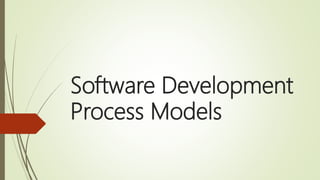The document discusses several software development process models:
- The waterfall model is a sequential process with distinct phases from conception to maintenance. It works well for small, stable projects.
- The prototype model develops throwaway prototypes for user feedback to refine requirements. It is useful for complex systems with significant user interaction.
- The incremental model produces working software in modules, with each release adding functionality until complete. It allows for flexibility and early delivery.
- The spiral model is iterative like the incremental model but emphasizes risk analysis in each phase. It is well-suited for large, critical projects.
- The agile model delivers working software frequently through rapid, incremental cycles with user collaboration, valuing interaction over process.


























